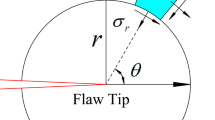Abstract
The damage growth in a softening interface connected to an elastic block is analysed. The elastic block, assumed to be infinite, is modelled as a two-dimensional continuum and the interface is one-dimensional with a constitutive response which follows a scalar damage model. The solution technique is based on the equilibrium of the interfacial forces resulting from the deformation of the elastic block and from the interface constitutive response. The interface failure process is compared to that of a hierarchical model which was obtained analytically (Delaplace et al., 1998). The two are found to be similar, without an internal length scaling the distribution of damage at the inception of macro-cracking. Finally, scale effects on the occurrence of bifurcation and instability are considered. It is shown that bifurcation may occur prior to or after the limit point under displacement control, depending on the elastic block height or stiffness.
Similar content being viewed by others
References
Bažant, Z.P. and Cedolin, L. (1991). Stability of Structures, Oxford University press.
Bažant, Z.P. and Planas, J. (1998). Fracture and Size Effect in Concrete and Other Quasi-Brittle Materials, CRC Press.
Daniels, H.E. (1945). The statistical theory of the strength of bundles of threads, Proceedings of the Royal Society, London, A183, 405–435.
De Borst, R. (1987). Computation of post-bifurcation and post failure behavior of strain softening solids. Computers and Structures 25, 211–224.
De Borst, R. (1988). Bifurcation in finite element models with a non-associated flow law. International Journal of Numerical and Analytical Methods in Geomechanics 12, 99–116.
Delaplace, A., Roux, S. and Pijaudier-Cabot, G. (1998). Damage cascade in a softening interface. International Journal of Solids and Structures, In press.
Hemmer, Per C. and Hansen, A. (1992). The distribution of simultaneous fiber failures in fiber bundles. Journal of Applied Mechanics 59, 909–914.
Hill, R. (1959). Some basic principles in the mechanics of solids without a natural time. Journal of the Mechanics and Physics of Solids 7, 209–225.
Hillerborg, A., Modeer, M. and Petersson, P.E. (1976). Analysis of crack formation and crack growth in concrete by means of fracture mechanics and finite elements. Cement and Concrete Research 6, 773–782.
Pijaudier-Cabot, G. and Huerta, A. (1991). Finite element analysis of bifurcation in nonlocal strain softening solids. Computer Methods in Applied Mechanics and Engineering 90, 905–919.
Timoshenko, S. (1948). Théorie de l'Élasticité, Librairie Polytechnique, Paris and Liege.
Author information
Authors and Affiliations
Rights and permissions
About this article
Cite this article
Delaplace, A., Roux, S. & Pijaudier-Cabot, G. Failure and scaling properties of a softening interface connected to an elastic block. International Journal of Fracture 95, 159–174 (1999). https://doi.org/10.1023/A:1018644116373
Issue Date:
DOI: https://doi.org/10.1023/A:1018644116373




